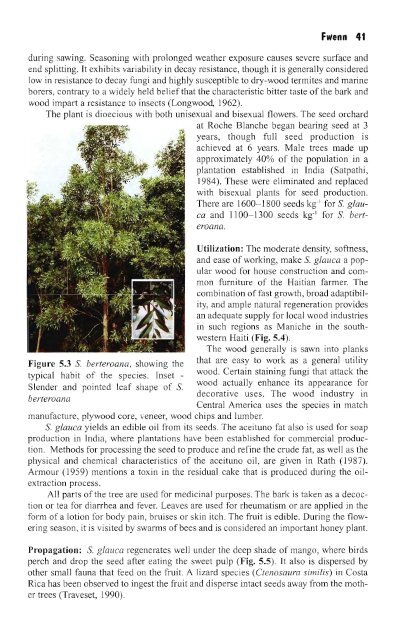Important Trees of Haiti
Important Trees of Haiti
Important Trees of Haiti
You also want an ePaper? Increase the reach of your titles
YUMPU automatically turns print PDFs into web optimized ePapers that Google loves.
Figure 5.3 S. berteroana, showing the<br />
typical habit <strong>of</strong> the species. Inset <br />
Slender and pointed leaf shape <strong>of</strong> S.<br />
berteroana<br />
Fwenn 41<br />
during sawing. Seasoning with prolonged weather exposure causes severe surface and<br />
end splitting. It exhibits variability in decay resistance, though it is generally considered<br />
low in resistance to decay fungi and highly susceptible to dry-wood termites and marine<br />
borers, contrary to a widely held beliefthat the characteristic bitter taste <strong>of</strong>the bark and<br />
wood impart a resistance to insects (Longwood, 1962).<br />
The plant is dioecious with both unisexual and bisexual flowers. The seed orchard<br />
at Roche Blanche began bearing seed at 3<br />
years, though full seed production is<br />
achieved at 6 years. Male trees made up<br />
approximately 40% <strong>of</strong> the population in a<br />
plantation established in India (Satpathi,<br />
1984). These were eliminated and replaced<br />
with bisexual plants for seed production.<br />
There are 1600-1800 seeds kg-I for S. glauca<br />
and 1100-1300 seeds kg-I for S. berteroana.<br />
Utilization: The moderate density, s<strong>of</strong>tness,<br />
and ease <strong>of</strong> working, make S. glauca a popular<br />
wood for house construction and common<br />
furniture <strong>of</strong> the <strong>Haiti</strong>an farmer. The<br />
combination <strong>of</strong> fast growth, broad adaptibility,<br />
and ample natural regeneration provides<br />
an adequate supply for local wood industries<br />
in such regions as Maniche in the southwestern<br />
<strong>Haiti</strong> (Fig. 5.4).<br />
The wood generally is sawn into planks<br />
that are easy to work as a general utility<br />
wood. Certain staining fungi that attack the<br />
wood actually enhance its appearance for<br />
decorative uses. The wood industry in<br />
Central America uses the species in match<br />
manufacture, plywood core, veneer, wood chips and lumber.<br />
S. glauca yields an edible oil from its seeds. The aceituno fat also is used for soap<br />
production in India, where plantations have been established for commercial production.<br />
Methods for processing the seed to produce and refine the crude fat, as well as the<br />
physical and chemical characteristics <strong>of</strong> the aceituno oil, are given in Rath (1987).<br />
Armour (1959) mentions a toxin in the residual cake that is produced during the oilextraction<br />
process.<br />
All parts <strong>of</strong> the tree are used for medicinal purposes. The bark is taken as a decoction<br />
or tea for diarrhea and fever. Leaves are used for rheumatism or are applied in the<br />
form <strong>of</strong> a lotion for body pain, bruises or skin itch. The fruit is edible. During the flowering<br />
season, it is visited by swarms <strong>of</strong> bees and is considered an important honey plant.<br />
Propagation: S. glauca regenerates well under the deep shade <strong>of</strong> mango, where birds<br />
perch and drop the seed after eating the sweet pulp (Fig. 5.5). It also is dispersed by<br />
other small fauna that feed on the fruit. A lizard species (Ctenosaura similis) in Costa<br />
Rica has been observed to ingest the fruit and disperse intact seeds away from the mother<br />
trees (Traveset, 1990).

















